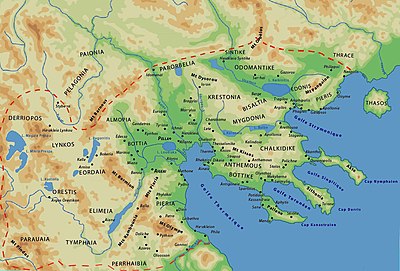Lower Macedonia
Lower Macedonia ( Greek κάτω Μακεδονία kátō Makedonía also Lower Macedonia ) is a geographical term that is used to summarize the low-lying coastal landscapes of ancient Macedonia . This term was used as early as the 5th century BC. By Thucydides , for his description of the domain of King Perdiccas II. The area in question was roughly congruent with today's Greek region of Central Macedonia, with the exception of the Chalkidiki peninsula.
Geographically, Lower Macedonia is delimited in the west by the mountain range of the Vermio (Bermion) , behind which Upper Macedonia rises, and in the southwest by that of the Olympos , which represents the border with Thessaly . In the north rise the mountain ranges of the Balkans , which were inhabited by the Paionians in ancient times . To the east, the valley of the Strymon (Struma) marked the border with Thrace . In the south, the country on the thermal gulf has access to the Aegean Sea , with a straight coastline interrupted by the Chalkidiki peninsula, which for historical reasons is not part of Lower Macedonia, although it was conquered in the late classical period.
Lower Macedonia differed from the mountainous Upper Macedonia, which is characterized by barren vegetation, in its abundance of water, which could be drawn from the rivers Aliakmonas , Lydias (Loudias) with its lake, Axios (Vardar) and Strymon (Struma) and which provided the conditions for an intense one guaranteed agricultural use of its land. In archaic times, the country was inhabited by various small tribes, which are occasionally added to the Phrygian ethnic group . From about the 12th century BC who migrated from the mountains of Upper Macedonia Coming Macedonians in the coastal region down and began to occupy the land between Olympos and the Axios. The long-established tribes of the Pierians and Bottiaians were pushed to the Chalkidiki and Thrace, only their names remained associated with their former residences. Pieria , Bottiaia (the Homeric Imathia ) and Amphaxitis with the Axios as the border river were the first Dutch areas settled by the Macedonians, who were able to establish an urban civilization there from an increasing population, which resulted from the high level of agriculture. Important cities included Beroia , Aigai , Mieza , Edessa , Pydna , Dion , Pella and Europos . Under the first Argeads , Pieria and Bottiaia formed a closed sovereign territory very early on, which became the basis of their later kingship that encompassed all of Macedonia.
Under Perdiccas II and his immediate ancestors, the royal power expanded in the 5th century BC, after which the consolidation of Lower Macedonia was completed. To the north Almopia and the Axios up the fortress Idomenai were won as a border to the Paionians. In the east, the annexation of Mygdonia , Krestonia and Bisaltia moved the border with the Thracians from Axios to Strymon. Under Archelaus I , Aigai was abandoned as the royal seat, which was relocated to the now more centrally located Pella.
The eastern border of Macedonia was only re-established by Philip II in the middle of the 4th century BC. BC moved beyond the Strymon to the Nestos , through the conquest of Odomantika , Edonia and Pieris to the Pangaion with its large gold deposits. Important cities here were Amphipolis , Herakleia Sintike and Philippi . The newly annexed land between Strymos and Nestos is no longer part of the historical region of Lower Macedonia. It covered the western section of what is now East Macedonia and Thrace .
literature
- Fritz Geyer: Macedonia up to Philip II's accession to the throne. In: Historische Zeitschrift , Vol. 30 (1930), pp. 1–148.
- William Greenwalt: Why Pella? , In: Historia: Zeitschrift für Alte Geschichte , Vol. 48 (1999), pp. 158-183.
- Joseph Roisman and Ian Worthington: A Companion to Ancient Macedonia (Blackwell Publishing Ltd., 2010)
